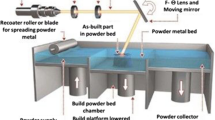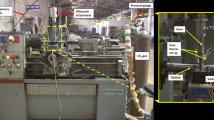Abstract
The main failure mode of a wheel–axle assembly, which is an important moving part of rail vehicles, in the interference fit zone is partial fatigue. Given that neither the plane analytical method nor the axisymmetric finite element method can reveal the local and stochastic contact stress concentration at the end of the wheel seat, this study analyzed various factors influencing a machined mating surface and found that the cylindricity error is a key factor in transforming the plane contact into a 3D contact. In addition, the experimental data of the pressing force applied to 60 groups of wheel–axle assemblies were analyzed, and the circumferential contour of the mating surface was found to conform to a beta distribution. Accordingly, a method for obtaining random interpolation points on the circumferential contour was proposed. To ensure the continuity of the mating surface, the circumferential Hermite interpolation method and the axial cubic interpolation method were employed, and the contact surface with random characteristics was modeled. Based on the random ergodicity of the mating surface, a small-sample 3D finite element model of a wheel–axle assembly was established using the random cylindricity error, and a calculation method for the 3D contact stress was proposed. Taking the RE2B axle of railway locomotive as an example, compared with the axisymmetric method, the inhomogeneity analysis of the contact stress of the small-sample model proposed in this paper could help explain the problem of local stress concentration at the end of the wheel seat. The analysis results showed that the maximum stress of the 3D model based on the cylindricity is greater than that of the axisymmetric model, enabling strength evaluation in the design of wheel–axle assemblies.


















Similar content being viewed by others
References
Yang, G.M., Coquille, J.C., Fontaine, J.F., Lambertin, M.: Contact pressure between two rough surfaces of a cylindrical fit. J. Mater. Process. Technol. 123, 490–497 (2002). https://doi.org/10.1016/s0924-0136(02)00139-5
Kato, K., Kayaba, T., Nitta, I., Shimoda, S.: The effect of surface roughness on fitting strength of shrink fit between ceramic and metal elements. J. Vib. Acoust. 111, 318–325 (1989). https://doi.org/10.1115/1.3269859
Bonisoli, E., Marcuccio, G., Venturini, S.: Interference fit estimation through stress-stiffening effect on dynamics. Mech. Syst. Signal Process. 160, 107 (2021)
Oila, A., Bull, S.J.: Assessment of the factors influencing micropitting in rolling/sliding contacts. Wear 258(10), 1510–1524 (2005)
Huang, Y.: Engineering Elasticity. Tsinghua University Press, Beijing (1982)
Civan F. Stress Dependency of Permeability Represented by an Elastic Cylindrical Pore-Shell Model: Comment on Zhu et al. (Transp Porous Med (2018) 122:235–252). Transp. Porous Media 2018; 127: 573–585https://doi.org/10.1007/s11242-018-1213-0
Sen, S., Aksakal, B.: Stress analysis of interference fitted shaft–hub system under transient heat transfer conditions. Mater. Des. 25, 407–417 (2004). https://doi.org/10.1016/j.matdes.2003.11.009
Strozzi, A., Baldini, A., Giacopini, M., Bertocchi, E., Bertocchi, L.: Normalization of the stress concentrations at the rounded edges of a shaft–hub interference fit. J. Strain Anal. Eng. Des. 46, 478–491 (2011). https://doi.org/10.1177/0309324711403845
Kanber, B.: Boundary element analysis of interference fits. Turk. J. Eng. Environ. Sci. 30, 323–330 (2007)
Özel, A., Temiz, Ş, Aydin, M.D., Şen, S.: Stress analysis of shrink-fitted joints for various fit forms via finite element method. Mater. Des. 26, 281–289 (2005). https://doi.org/10.1016/j.matdes.2004.06.014
Han, C., Zhang, J.: Interference assembly and fretting wear analysis of hollow shaft. Sci. World J. 2014, 919518–919518 (2014). https://doi.org/10.1155/2014/919518
Croccolo, D., De Agostinis, M., Vincenzi, N.: Normalization of the stress concentrations at the rounded edges of a shaft–hub interference fit: extension to the case of a hollow shaft. J Strain Anal Eng Des 47, 131–139 (2012). https://doi.org/10.1177/0309324712439982
Lanoue, F., Vadean, A., Sanschagrin, B.: Fretting fatigue strength reduction factor for interference fits. Simul. Model. Pract. Theory 19, 1811–1823 (2011). https://doi.org/10.1016/j.simpat.2011.05.004
Lanoue, F., Vadean, A., Sanschagrin, B.: Finite element analysis and contact modelling considerations of interference fits for fretting fatigue strength calculations. Simul. Model. Pract. Theory 17, 1587–1602 (2009). https://doi.org/10.1016/j.simpat.2009.06.017
Luo, H.Y., Liu, C.J., Li, K.: Contacting model considerations of interference fit for shaft-hub system. Adv. Mater. Res. 118–120, 294–298 (2010). https://doi.org/10.4028/www.scientific.net/amr.118-120.294
Paredes, M., Nefissi, N., Sartor, M.: Study of an interference fit fastener assembly by finite element modelling, analysis and experiment. Int J Interact Des Manuf 6, 171–177 (2012). https://doi.org/10.1007/s12008-012-0146-z
Yang, G.M., Coquille, J.C., Fontaine, J.F., Lambertin, M.: Influence of roughness on characteristics of tight interference fit of a shaft and a hub. Int. J. Solids Struct. 38, 7691–7701 (2001). https://doi.org/10.1016/s0020-7683(01)00035-x
Lorenz, S.J., Sadeghi, F., Trivedi, H.K., et al.: A continuum damage mechanics finite element model for investigating effects of surface roughness on rolling contact fatigue. Int. J. Fatigue 143(3), 105986 (2021)
Wang, X., et al.: The effect of resolution on the deterministic finite element elastic-plastic rough surface contact under combined normal and tangential loading. Tribol. Int. 144, 106141 (2019)
Fontaine, J.F., Siala, I.E.: Form defect influence on the shrinkage fit characteristics. Eur. J. Mech. A Solids 17, 107–119 (1998). https://doi.org/10.1016/s0997-7538(98)80066-1
Dudziak, M., Domek, G., Kołodziej, A., Talaśka, K.: Contact problems between the hub and the shaft with a three-angular shape of cross-section for different angular positions. Proc. Eng. 96, 50–58 (2014). https://doi.org/10.1016/j.proeng.2014.12.097
Dudziak, M., Domek, G., Kołodziej, A.: Variation of static parameters of cooperation in axisymmetric connection. Proc. Eng. 136, 56–62 (2016). https://doi.org/10.1016/j.proeng.2016.01.174
Sogalad, I., Ashoka, H.N., Udupa, N.G.S.: Influence of cylindricity and surface modification on load bearing ability of interference fitted assemblies. Precis. Eng. 36, 629–640 (2012). https://doi.org/10.1016/j.precisioneng.2012.05.005
Tsai, J.-C., Chou, T.-T., Chang, C.-K.: Statistical analysis of contact stiffness for shaft-bearing assembly with tolerancing and fit. Proc. CIRP 92, 45–50 (2020). https://doi.org/10.1016/j.procir.2020.05.170
Ulrich, D., Binz, H.: An enhanced design method for 3D contact surfaces on shaft–hub connections joined through lateral extrusion. Appl. Eng. Sci. 6, 100047 (2021)
Ulrich D, Binz H, Meiner R, et al.: Iterative design method for plastically stressed shaft- hub connections with optimized contact stress. In: NAFEMS World Congress 2019. 2019
Boca, M., Nagit, G., Cioată, F.: Aspects concerning the circularity and cylindricity deviation of a work piece processed by turning. MATEC Web of Conferences 112, 01020 (2017). https://doi.org/10.1051/matecconf/201711201020
Chamble, P., Bharath, M.R., Lokeshaa, K., Singh, S.C.: Machine tool vibration on dimensional accuracy and surface roughness during milling operation of Al6082 with indexable carbide inserts. J. Appl. Res. Technol. (2020). https://doi.org/10.22201/icat.24486736e.2020.18.2.999
Wei, Y.: Some mathematical models of measurement of cylindricity error with multi-point method. J. China Text. Univ. (Engl. Ed.) 2, 34–39 (1996)
Sun, Q., Liu, X., Mu, X., Gao, Y.: Estimation for normal contact stiffness of joint surfaces by considering the variation of critical deformation. Assem. Autom. 40, 399–406 (2020). https://doi.org/10.1108/aa-03-2019-0059
Wang, H., Yu, Y., Yu, J., Duan, J., Zhang, Y., Li, Z., et al.: Effect of 3D random pitting defects on the collapse pressure of pipe—part I: experiment. Thin Wall. Struct. 129, 512–526 (2018). https://doi.org/10.1016/j.tws.2018.04.015
Liu, X., Zhang, J., He, M., et al.: Influence of interference on process of wheel-shaft pressing. Mech. Sci. Technol. Aerosp. Eng. (2019).
Gao, J.: Railway Vehicle Wheelset Assembly Technical Conditions. China Railway Publishing House, Beijing (2017)
Anonymous: Railway Freight Car Wheelset and Rolling Bearing Assembly and Maintenance Rules. China Railway Publishing House, Beijing (1998)
Wang T, Fan Z. Finite element analysis of wheel and axle pressing process. Computer Aided Engineering, 2017(1) (Chinese)
Bing, Y., Zhen, L., Shoune, X., et al.: Effect of loading waveform on fatigue crack growth behavior of LZ50 axle steel. J. China Railw. Soc. 042(005), 44–50 (2020) (Chinese)
Acknowledgements
This research was supported by the project of Research on Crack Detection of Brake Hoops of Wheel–axle Based on Acoustic Emission Technology (No. M13L00420) from CRRC QINGDAO SIFANG CO., LTD. The authors would like to sincerely thank all the anonymous reviewers for their valuable comments that greatly helped improve the manuscript.
Author information
Authors and Affiliations
Contributions
C.W. involved in conceptualization, methodology, simulation, validation, and writing–original draft; H.Q. involved in conceptualization, methodology, and review and editing; W.H. involved in simulation, validation, and review and editing; D.H. involved in formal analysis and review and editing.
Corresponding author
Ethics declarations
Conflict of interest
The authors declare that they have no conflicts of interest to this work. We do not have any commercial or associative interest that represents a conflict of interest in connection with the work submitted.
Ethics approval and consent to participate
Not applicable.
Additional information
Publisher's Note
Springer Nature remains neutral with regard to jurisdictional claims in published maps and institutional affiliations.
Appendix 1: Introduction of beta distribution
Appendix 1: Introduction of beta distribution
The beta distribution refers to a set of continuous probability distributions defined in the interval (0,1), and its probability density function is:
where \(\alpha \ge 0, \, \beta > 0\).
Mathematical expectation and variance are expressed as follows:
\(\Gamma ( \cdot )\) represents the \(\Gamma\) distribution:
Rights and permissions
About this article
Cite this article
Wang, CP., Qi, HY., Hao, WX. et al. Three-dimensional contact surface modeling and stress analysis of interference fit based on cylindricity error. Arch Appl Mech 92, 993–1014 (2022). https://doi.org/10.1007/s00419-021-02089-8
Received:
Accepted:
Published:
Issue Date:
DOI: https://doi.org/10.1007/s00419-021-02089-8




